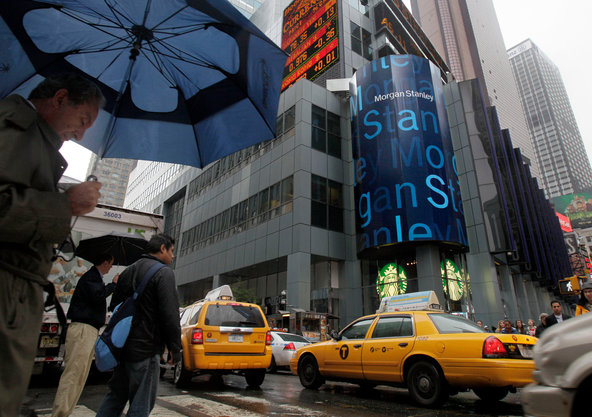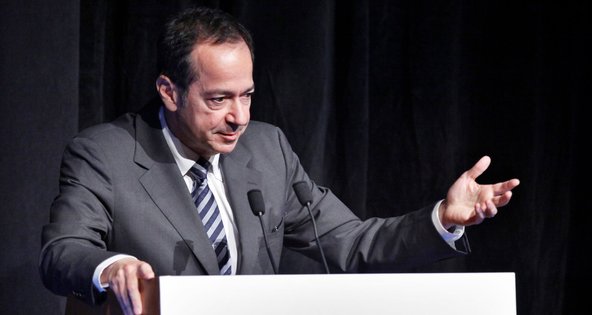 Richard Drew/Associated PressThe headquarters of Morgan Stanley in Manhattan.
Richard Drew/Associated PressThe headquarters of Morgan Stanley in Manhattan.
On March 16, 2007, Morgan Stanley employees working on one of the toxic assets that helped blow up the world economy discussed what to name it. Among the team members’ suggestions: “Subprime Meltdown,” “Hitman,” “Nuclear Holocaust” and “Mike Tyson’s Punchout,” as well a simple yet direct reference to a bag of excrement.
Ha ha. Those hilarious investment bankers.
Then they gave it its real name and sold it to a Chinese bank.
We are never going to have a full understanding of what bad behavior bankers engaged in in the years leading up to the financial crisis. The Justice Department and the Securities and Exchange Commission have failed to hold big wrongdoers to account.
The Trade
View all posts
We are left with what scraps we can get from those private lawsuits lucky enough to get over the high hurdles for document discovery. A case brought in a New York State Supreme Court in Manhattan against Morgan Stanley by a Taiwanese bank, which bought a piece of the same deal the Chinese bank did, has cleared that bar.
The results are explosive. Hundreds of pages of internal Morgan Stanley documents, released publicly last week, shed much new light on what bankers knew at the height of the housing bubble and what they did with that secret knowledge.
The lawsuit concerns a $500 million collateralized debt obligation called Stack 2006-1, created in the first half of 2006. Collections of mortgage-backed securities, C.D.O.’s were at the heart of the financial crisis.
But the documents suggest a pattern of behavior larger than this one deal: people across the bank understood that the American housing market was in trouble. They took advantage of that knowledge to create and then bet against securities and then also to unload garbage investments on unsuspecting buyers.
Morgan Stanley doesn’t see the narrative as the plaintiffs do. The firm is fighting the lawsuit, contending that the buyers were sophisticated clients and could have known what was going on in the subprime market. The C.D.O. documents disclosed, albeit obliquely, that Morgan Stanley might bet against the securities, a strategy known as shorting. The firm did not pick the assets going into the deal (though it was able to veto any assets). And any shorting of the deal was part of a larger array of trades, both long and short. Indeed, Morgan Stanley owned a big piece of Stack, in addition to its short bet.
Regarding the profane naming contest, Morgan Stanley said in a statement: “While the e-mail in question contains inappropriate language and reflects a poor attempt at humor, the Morgan Stanley employee who wrote it was responsible for documenting transactions. It was not his job or within his skill set to assess the state of the market or the credit quality of the transaction being discussed.”
Philip Blumberg, the Morgan Stanley lawyer who composed most of the names, meet the underside of a bus, courtesy of your employer.
Another Morgan Stanley employee sent an e-mail that same morning, suggesting that the deal be called “Hitman.” This might have been an attempt to manage up, because “Hitman” was the nickname of his boss, Jonathan Horowitz, who helped head the part of the group that oversaw mortgage-backed C.D.O.’s. Mr. Horowitz replied, “I like it.”
Both Mr. Blumberg and Mr. Horowitz, now at JPMorgan, declined to comment through representatives at their banks.
In February 2006, Morgan Stanley began putting together the Stack C.D.O. According to an internal presentation, Stack “represents attractive business for Morgan Stanley.”
Why? In addition to fees, another bullet point listed: “Ability to short up to $325MM of credits into the C.D.O.” In other words, Morgan Stanley could — and did — sell assets to the Stack C.D.O., intending to profit if the securities backed by those assets declined. The bank put on a $170 million bet against Stack, even as it was selling it.
In the end, of the $500 million of assets backing the deal, $415 million ended up worthless.
“While investors and taxpayers all over the world continue to choke on Wall Street’s toxic subprime products, to this day not a single major Wall Street executive has been held accountable for misconduct relating to those products,” said Jason C. Davis, a lawyer at Robbins Geller who is representing the plaintiff in the lawsuit. “They are generally untouchable, but we are pleased that the court in this case is ordering Morgan Stanley to turn over damning evidence, so that the jury will get to see what Morgan Stanley really knew about the troubled nature of its supposedly ‘higher-than-AAA’ quality product.”
Why might Morgan Stanley have bet against the deal? Did its traders develop a brilliant thesis by assessing the fundamentals of the housing market through careful analysis of the public data? The documents suggest something more troubling: bankers found out that the housing market was diseased from their colleagues down the hall.
Bankers were getting information from fellow employees conducting and receiving private assessments of the quality of the mortgages that the bank would purchase to back securities. These reports weren’t available to the public. It would be crucial information for trading in securities backed by those kinds of mortgages.
In one e-mail from Oct. 21, 2005, a Morgan Stanley employee warned a banker that the mortgages Morgan Stanley was buying from loan originators were troubled. “The real issue is that the loan requests do not make sense,” he wrote. As an example, he cited “a borrower that makes $12K a month as an operation manger (sic) of an unknown company — after research on my part I reveal it is a tarot reading house. Compound these issues with the fact that we are seeing what I would call a lot of this type of profile.”
In another e-mail from March 17, 2006, another Morgan Stanley employee wrote about a “deteriorating appraisal quality that is very flagrant.”
Two of the employees who received those e-mails joined an internal hedge fund, headed by Howard Hubler, that was formed only the next month, in April 2006. As recounted in Michael Lewis’s “The Big Short,” Mr. Hubler infamously bet against the subprime market on Morgan Stanley’s behalf, a fact that Morgan Stanley’s chief financial officer conceded in late 2007. Mr. Hubler’s group was supposed to be separate from the rest of Morgan Stanley, but the two bankers continued to receive similar information about the underlying market, according to a person briefed on the matter.
At no point did they receive material, nonpublic information, a Morgan Stanley spokesman says.
I struggle to see how the private assessments that the subprime market was imploding were immaterial.
Another of Morgan Stanley’s main defenses is that it couldn’t have thought the investment it sold to the Taiwanese was terrible because it, too, lost money on securities backed by subprime mortgages. As the Morgan Stanley spokesman put it, “This deal must be viewed in the context of a significant write-down for Morgan Stanley in 2007, when the firm recorded huge losses in its public securities filings related to other subprime C.D.O. positions.”
This is a common refrain offered by big banks like Citigroup, Merrill Lynch and Bear Stearns to absolve them of any responsibility.
But does losing money wipe away sin?
Yes, Mr. Hubler made his bets in what turned out to be a deeply disastrous way. As part of a complex array of trades, he bet against the middle slices of subprime mortgage C.D.O.’s. He bought the supposedly safe top parts. The income from the top slices helped offset the cost of betting against the middle slices. But when the market collapsed, the top slices — called “super senior” because they were supposedly safer than Triple A — didn’t hold their value, losing billions for Mr. Hubler and Morgan Stanley. Mr. Hubler did not respond to requests for comment.
So Morgan Stanley lost a great deal of money.
But let’s review what the documents suggest is the big picture.
In the fall of 2005, bank employees shared nonpublic assessments of how the subprime market was a house of tarot cards.
In February 2006, the bank began creating Stack in part so that it could bet against it.
In April 2006, the bank created its own internal hedge fund, led by Mr. Hubler, who shorted the subprime market. Among the traders in this internal shop were people who helped create Stack and other deals like it, and at least two employees who had access to the private due diligence reports.
Mr. Hubler’s group had no investment position in Stack, according to the person briefed on the matter, but it sure looks as if the bank saw what was coming and tried to position itself for a subprime market collapse.
Finally, by early 2007, the bank appeared to realize that the subprime market was faring even worse than it expected. Even the supposedly safe pieces of C.D.O.’s that it owned, including its piece of Stack, were facing losses. So Morgan Stanley bankers set to scouring the world to peddle as a safe and sound investment what its own employees were internally deriding.
Morgan Stanley declined to comment on whether it made money on its Stack investments over all. But it looks to have turned out well for the bank. In Stack, it managed to fob off a nuclear bomb to the Taiwanese bank.
Unfortunately for Morgan Stanley, it had so many other pieces of C.D.O.’s, so many nuclear warheads, that it couldn’t find nearly enough suckers around the world to buy them all.
And so when the real collapse came, Morgan Stanley was left with billions of dollars in losses.
That hardly seems exculpatory.
Article source: http://dealbook.nytimes.com/2013/01/23/financial-crisis-lawsuit-suggests-bad-behavior-at-morgan-stanley/?partner=rss&emc=rss




